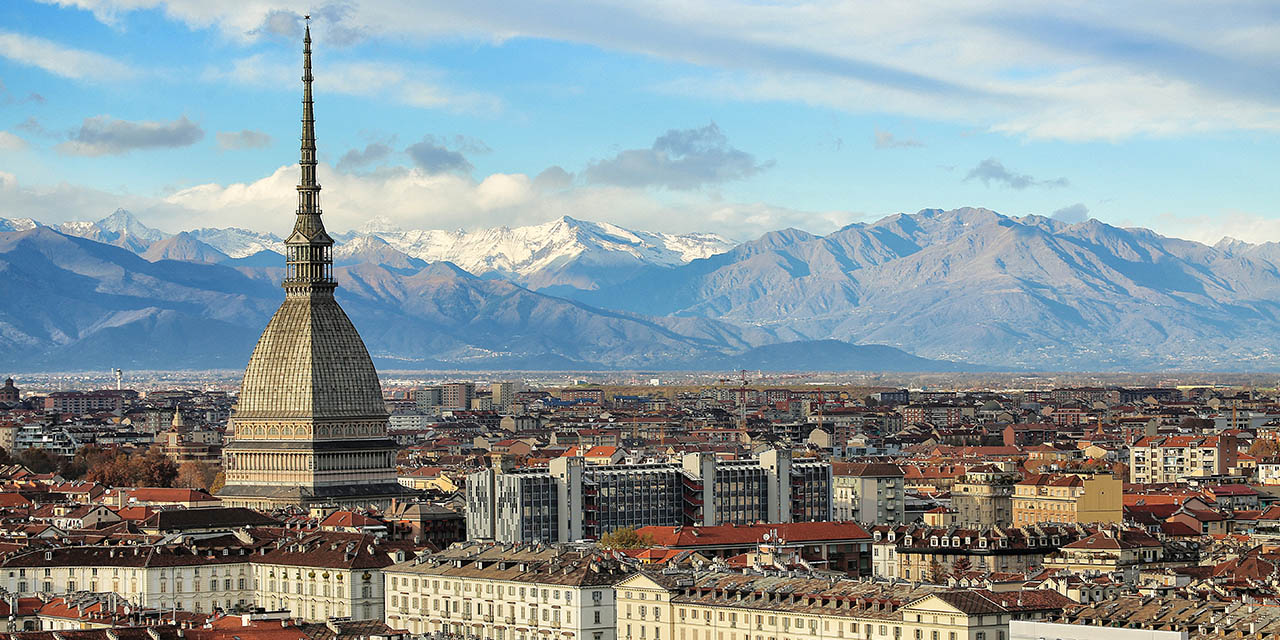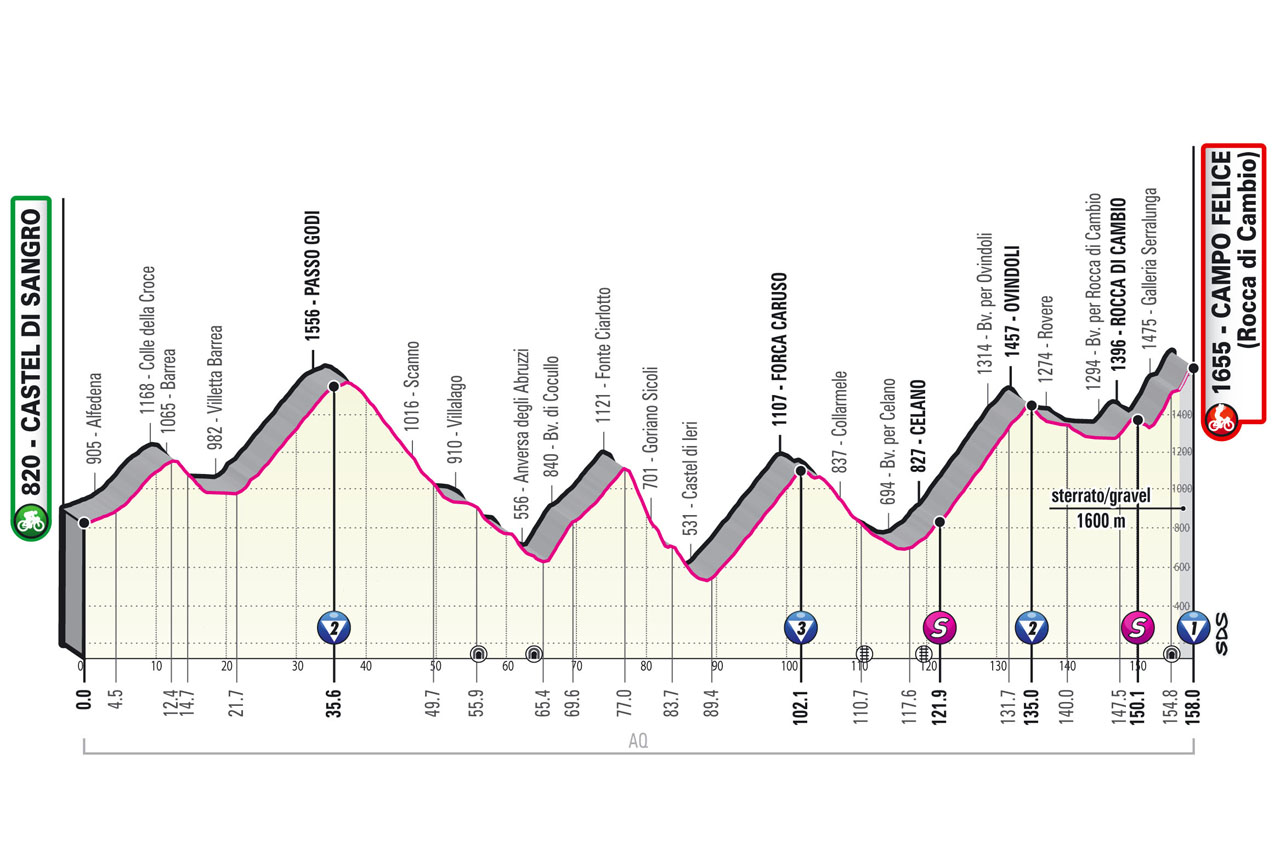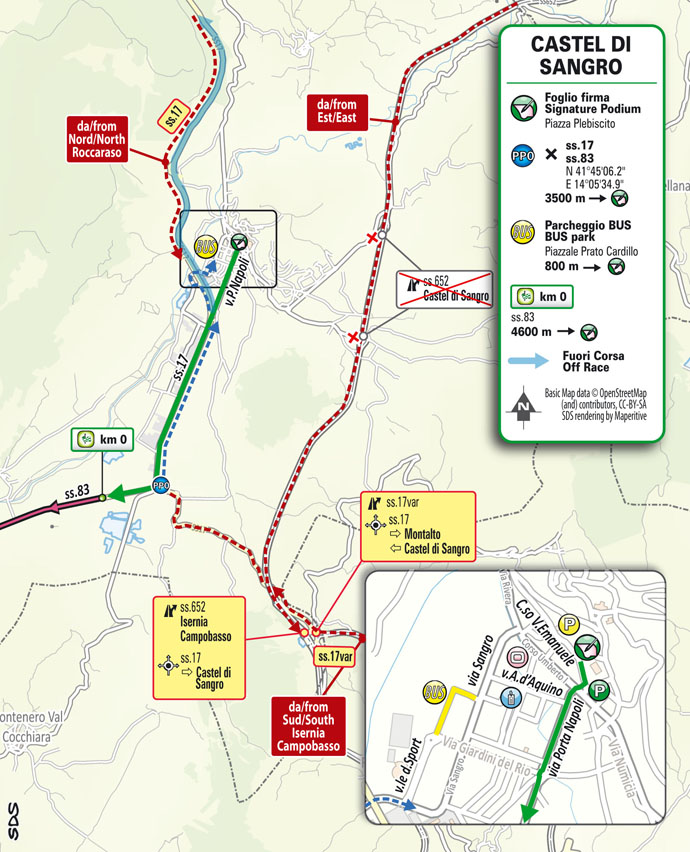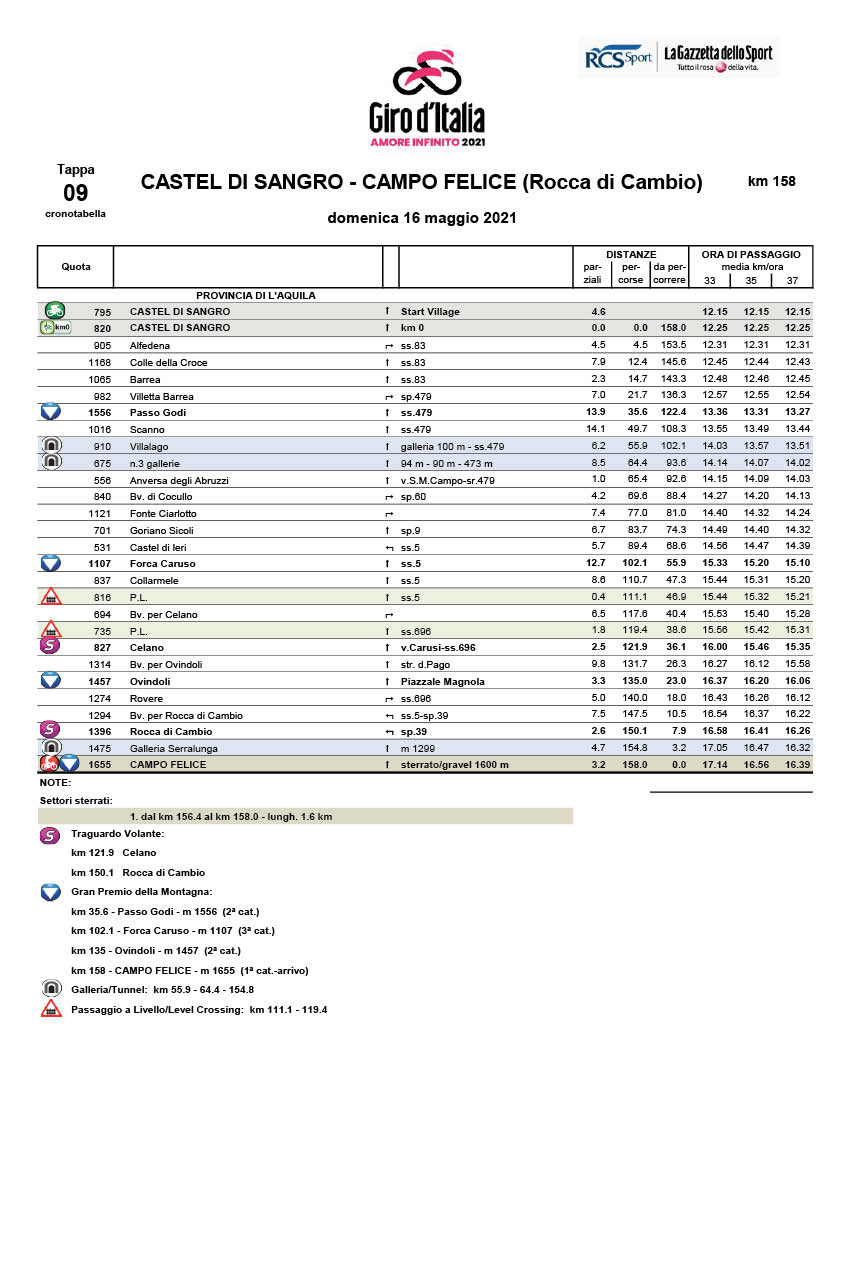profile
map
technical info
This queen stage across the Apennines of Abruzzo takes in several ascents, including 4 categorised climbs. From the start until Celano, the route takes in a succession of long climbs on moderately wide roads, followed by sometimes technical descents. Past Ovindoli (categorised climb), the route enters the Piana delle Rocche and becomes somewhat easier, up to Rocca di Cambio. Here, the course makes for Campo Felice, taking in the closing climb.
Final kilometres
The final climb is nearly 6 km long, and the gradients are not very sharp. After a long, well-lit tunnel stretching from 3 to 2 km remaining to the finish, the final 1,600 metres, as well as the home straight, are on unpaved roads, with peaks topping out at 14% over the last 500 m.
start / finish
climb detail
final kilometres
itinerary timetable
tourist info
Host city:
Castel di Sangro
Overview
Castel di Sangro, called Aufidena by the Samnites, is the little town stretches down the hill slope as far as the confluence of the river Sangro with the Zittola where the bridge and ancient tavern mark the junction of the “tratturi” (sheep tracks) Celano- Foggia (Puglia) and Pescasseroli – Calenda (Puglia). The fortunate location of the trade and communications crossroad for the entire Abruzzo Region, fostered the growth of the town and underscored its role as “gateway to Abruzzo”. A flourishing sheep-rearing economy, furthered growth throughout the upper Sangro territory, brought advance of a wealthy shepherd class and the fortune of several confraternities, including the Santissimo Sacramento brotherhood who achieved sufficient social and artistic works, including rebuilding of the Assunta Collegiate (Convento dell’Assunta). The most interesting monument would have to be to the basilica of Santa Maria Assunta, put on the top of the mountain, is visible from all over the city. The basilica was rebuilt between 1695 and 1725, over the remain old church to a design by Francesco Ferradini of Como. Interesting some fews now remains of the ancient castle, documented at the end of the 9th cent. And indicated as a fortified location in the mid 12th, except for a few fragments and the lower part of a watchtower. Part of historical Aufidenate museum, set up at the end of the 1800 and closed due to wartime events, has now been opened in the renovated cloisters of the 16th cent Maddalena Convent. Castel di Sangro was the birthplace of famous Italian painter Teofilo Patini. In the center of the city is Piazza Plebiscito, an important place in the history of the unity of Italy. On 21 October 1860 the ambassadors gave the king Vittorio Emanuele II the positive results of the plebiscites for the annexation of the other southern provinces to the Kingdom of Italy.
Castel di Sangro is a center of great summer and winter tourist activities.
Known for the wealth of its sports facilities, the city hosts sporting events for amateurs and professionals. The city has numerous sports and accommodation facilities, suitable for practicing the major sports: football, basketball, tennis (the city is the Fit center – federal tennis center), sport fishing, water sports, swimming, cycling, motocross etc. A cycle path of about 10 km runs through the whole city and connects every part of it, the commercial and residential ones.
Outside the city, the Alto Sangro tourist area offers ski slopes and services of all kinds to winter tourism and to summer tourism the opportunity to visit mountain places of great excellence. The great out-of-town attraction of Castel di Sangro is the Abruzzo trans-Siberian, a fascinating experience, panoramic and at low speed, aboard a vintage train with restored carriages dating back to the early twentieth century. The historic train on the Sulmona-Isernia railway is a real museum in movement inside and outside the window, a showcase of a still authentic territory between Abruzzo and Molise and crosses two national parks and a nature reserve: the Majella National Park, the National Park
Gastronomy
Among the typical dishes to try: Cazzarielli and faciuli (fresh pasta and beans), pasta con gli orapi (fresh pasta with wild spinach) , pecora al cotturo (sheep wet)
The Pigna cake is a golden-brown donut, made from a long leavening process, softened by lard and flavored with aniseed. Other sweet is fafette, made from cooked wine must, also known in the Abruzzo tradition as mostaccioli. A local beer is also produced in Castel di Sangro, it’s called “Eva” from the Abruzzese Brewery.
Campo Felice (Rocca di Cambio)
Overview
Rocca di Cambio on the ridge at the foot of Montecagnois is the highest town in Abruzzo (1433 m.) and was the chosen holiday place of Emperor Otto (9th – 10th cent.) It’s situated in The Rocche plateau between the Velino and Sirente massif and has an elevation of 1433 m. The area is encompassed within the only regional park in Abruzzo. Up to 50 years ago Rocca di Cambio lived on menager agriculture, on small sheep and cattle farms. Only from the beginning of the fifties, in the local economy, the first signs of a positive change were from the Municipality since 1951 for the revaluation of the historic center, to the road system, to the hotel sector and to tourism development.
The village was founded as a medieval stronghold by the Lombards in the 9th century. In the mid-thirteenth century, the town participated together with the other villages of the Aquila basin in the foundation of L’Aquila, under the dominion of the Anjou. The town became autonomous in 1849, when it recovered its status as an autonomous municipality. The small town began to modernize only after World War II and a sign of this new course the electric light and viable roads.
Gastronomy
From the sheep tradition Agnello in umido (Lamb wet) , Cardo in brodo (Thistle in broth), frittata agli orapi (omelette with wild spinach), Castrato con le patate (wether with potatoes) and the Pizza sfogliata (pizza puff pastry): flour, lard and eggs, simple ingredients for the puff pastry, a typical dessert of Rocca di Cambio. A poor dish of the local culinary tradition. The pizza sfogliata was cooked to pay for the journey of the deceased would have made to the afterlife, and during the wake a piece was also cut to pay homage to the deceased.
Main sights
In the centre the church of the Annunziata (15th cent.) feature contemporary baptismal font and tabernacle in th 14th century of Abruzzo-style. On the other side the Abbey of S.Lucia with was found in te 14th century. Its presbytery is adorned with shrinking 14th – century frescoes.
The creation of the Campo Felice ski resort was his greatest commitment, and the drive that led to a precise turnaround in the local economy. 4km southwest of Rocca di Cambio, the Brecciara chairlift runs up to Campo Felice (1550m) a major ski resort. In the ’65, ’66, and ’68 Rocca di Cambio rose to national prominence as the stage venue of the Giro d’Italia. Unforgettable occasions for the history of this town. Personalities from the world of sports, journalism, television, all there, in that small mountain center: Torriani, Zavoli, De Zan, Merckx, Anquetil, Gimondi, Adorni, Raschi, Altig, Motta, Taccone. The resort has a modern fully automated system, equipped with 380 cannons, capable of snowing over 35 km of slopes, a cutting-edge technology, that ensures maximum snow production, even at marginal temperatures, and the use of all cold hours. The water requirement of the plant, which is completely autonomous, is ensured by two storage lakes with a capacity of 82 million liters created in a natural stream at the base of the Cisterna chairlift and one inserted in the Cerchio parking area. The resort boasts 15 downhill runs, spanning 40 km. Cross-country enthusiasts are also catered for with several routes that weave around the plateau and various trail. Campo Felice is also a paradise for children: thanks to the “Manovia Baby” they have a dedicated space to learn to ski with more ease and tranquility. Fun is then guaranteed with the “Fun Kids Area”: the “Snow Tubing” park, served by a carpet about 90 meters long and located at the “Campo Scuola” slope, awaits adults and children every weekend. The resort is also accessible from Tornimparte A24 motorway exit.
Among the many protagonists of the world of culture, sport and politics who were guests of Rocca di Cambio, we cannot fail to mention the Abruzzese Ignazio Silone, who wrote the last chapter of the famous novel “Emergency Exit” here. Today, Rocca di Cambio with its 478 inhabitants, is an established center of tourism and winter sports that many also prefer as a destination for summer holidays.








































































































